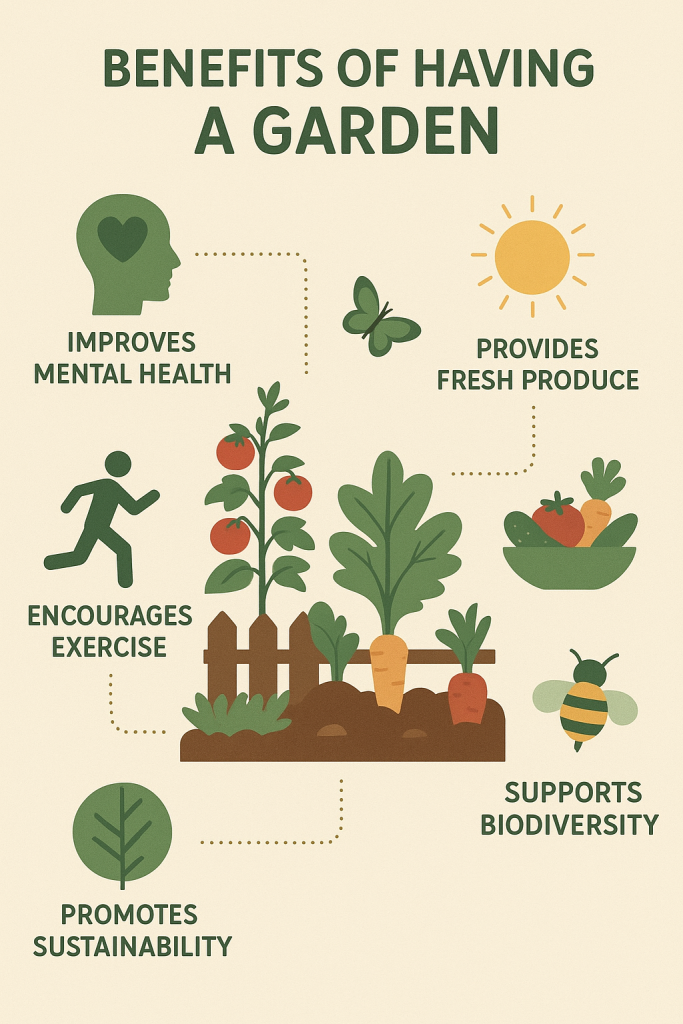Introduction: Why Backyard Veggies and Fruits Are the Best Investment You’ll Ever Make
Backyard veggies and fruits aren’t just about food—they’re about freedom, health, and joy. Imagine stepping outside your door, reaching for a ripe tomato, fresh cucumber, or sweet strawberry, and enjoying produce that you grew with your own hands. A backyard garden turns your space into a living pantry, reduces your grocery bill, and nourishes your body with nutrient-dense, chemical-free foods.
In this ultimate guide, we’ll explore everything you need to know about backyard gardening—how to grow veggies and fruits in your backyard, which crops thrive best, how to manage soil, water, and sunlight, and even how gardening impacts your mental health. We’ll also back it up with studies, expert insights, and practical tips to make sure your backyard garden thrives year after year.
Whether you’re a beginner or a seasoned green thumb, this post will show you how to create a backyard garden that’s not only productive but deeply rewarding.
Why Backyard Veggies and Fruits Are the Best Investment You’ll Ever Make
The Benefits of Backyard Veggies and Fruits
Backyard gardening isn’t just about growing food—it’s about transforming your lifestyle. Here are the biggest benefits of backyard veggies and fruits, supported by research and real-world results.
1. Superior Nutrition and Flavor
Backyard produce is fresher, meaning higher nutrient retention. A University of California study found that spinach loses 50% of its vitamin C within 24 hours of harvest. When you grow at home, you eat at peak freshness.
2. Major Cost Savings
According to the National Gardening Association, the average gardener spends $70 annually on seeds and supplies but grows $600 worth of produce. That’s nearly a 750% return on investment.
3. Stress Relief and Mental Health Boost
Gardening is a natural stress reducer. A Dutch study published in Journal of Health Psychology found that just 30 minutes of gardening lowered cortisol levels significantly compared to reading indoors.
4. Physical Exercise Without a Gym
Weeding, digging, carrying soil, planting—these movements burn calories and improve mobility. The CDC classifies gardening as moderate physical activity, which can burn 250–500 calories per hour.
5. Environmental Benefits
Home gardens reduce your reliance on industrial agriculture, which contributes heavily to greenhouse gas emissions. Plus, planting trees, shrubs, and veggies helps improve local air quality and soil biodiversity.
6. A Teaching Tool for Kids
Children who garden are more likely to eat vegetables and develop lifelong healthy habits, according to the American Journal of Public Health. It’s a hands-on way to teach patience, responsibility, and appreciation for food.
7. Community and Connection
Backyard gardening often sparks neighborly exchanges—sharing surplus zucchini, tomatoes, or herbs. Over time, this builds stronger communities and promotes local resilience.
8. Emergency Food Security
A productive backyard can act as a mini food insurance policy. During disruptions (economic, supply chain, or weather-related), having access to your own food is priceless.
Table of Contents
- The Benefits of Growing Backyard Veggies and Fruits
- Planning Your Backyard Garden
- Best Backyard Veggies to Grow
- Best Backyard Fruits to Grow
- Understanding Soil, Compost, and Fertility
- Watering and Sunlight Essentials
- Container Gardening and Small Spaces
- Companion Planting for a Healthier Backyard Garden
- Natural Pest Control and Organic Practices
- Seasonal Planting Guide: Spring, Summer, Fall, Winter
- Harvesting and Storage Tips
- How a Backyard Garden Improves Health and Well-being
- Cost Savings and Financial Benefits
- Common Mistakes to Avoid in Backyard Gardening
- Inspiring Backyard Garden Layout Ideas
- Conclusion: Your Backyard, Your Food Oasis
1. The Benefits of Growing Backyard Veggies and Fruits
Freshness and Flavor Like Nothing from a Store
Produce from the supermarket often travels thousands of miles before it reaches your plate. Studies show that fruits and veggies begin losing nutrients within 24 hours of being harvested. Your backyard garden eliminates this problem. When you pick lettuce, kale, or berries straight from the garden, you’re enjoying maximum flavor and nutrition.
A Natural Health Booster
A 2017 meta-analysis published in Preventive Medicine Reports found that gardening is linked to reduced stress, better mental health, and increased physical activity. Eating your own backyard veggies and fruits also means more fiber, antioxidants, and vitamins in your daily diet.
Environmental Impact
When you grow food in your backyard, you reduce your carbon footprint. No transport, no packaging, fewer chemicals—just food straight from your soil to your table.
A Family and Community Builder
Gardening together builds bonds. Kids who grow veggies are more likely to eat them, according to a University of Florida study. Backyard gardens also encourage community sharing, as neighbors often trade surplus zucchinis for tomatoes or herbs.
2. Planning Your Backyard Garden
Assessing Space and Sunlight
Backyard veggies and fruits thrive on sunlight. Most crops need 6–8 hours of direct sunlight daily. Map your backyard and note which areas get the most consistent light.
Choosing Between Raised Beds, Rows, or Containers
- Raised beds improve drainage and make soil management easier.
- Traditional rows work well for larger yards.
- Containers are perfect for patios or limited spaces.
Deciding What to Grow
Start with easy, high-yield plants. Think tomatoes, peppers, strawberries, and lettuce. Then expand to more challenging crops as your skills grow.
3. Best Backyard Veggies to Grow
Tomatoes
The king of backyard veggies. Rich in lycopene, vitamin C, and antioxidants, they thrive in warm, sunny spots.
Leafy Greens (Lettuce, Spinach, Kale)
Quick-growing and perfect for continuous harvest. Greens are excellent for beginners because they tolerate partial shade.
Cucumbers
Crisp, hydrating, and prolific growers. Trellis them to save space.
Peppers
Both sweet and hot peppers add color, flavor, and nutrients to meals.
Root Vegetables (Carrots, Radishes, Beets)
Easy to sow directly into the soil and ideal for cool weather.
4. Best Backyard Fruits to Grow
Strawberries
Perfect for small gardens. A single bed can produce bowls of sweet berries.
Blueberries
Require acidic soil, but once established, they yield heavily for years.
Raspberries and Blackberries
Perennial bushes that provide fruit year after year.
Apples and Pears
Backyard fruit trees are a long-term investment. Choose dwarf varieties if space is limited.
Grapes
Great for arbors or fences, grapes add beauty and functionality to your garden.
5. Understanding Soil, Compost, and Fertility
Healthy soil = healthy plants.
- Soil Testing: Before planting, test pH and nutrient levels. Most veggies prefer slightly acidic soil (pH 6–6.5).
- Composting: Kitchen scraps, grass clippings, and leaves can become nutrient-rich compost. A study in Waste Management found that compost not only improves soil fertility but also boosts microbial diversity.
- Organic Fertilizers: Bone meal, fish emulsion, and seaweed extracts are excellent natural boosters.
6. Watering and Sunlight Essentials
- Deep watering encourages deep root growth.
- Drip irrigation systems save water and reduce fungal diseases.
- Water in the morning to reduce evaporation and disease risks.
7. Container Gardening and Small Spaces
No big yard? No problem.
- Herbs (basil, thyme, mint) grow well in pots.
- Tomatoes and peppers thrive in 5-gallon containers.
- Vertical gardening with trellises and hanging baskets makes the most of balconies and patios.
8. Companion Planting for a Healthier Backyard Garden
Certain plants thrive together:
- Tomatoes + Basil: Boost flavor and repel pests.
- Carrots + Onions: Onion scent deters carrot flies.
- Corn + Beans + Squash: The Native American “Three Sisters” method provides mutual support and nutrients.
9. Natural Pest Control and Organic Practices
Skip harsh chemicals. Instead:
- Introduce ladybugs for aphid control.
- Use neem oil as a natural pesticide.
- Plant marigolds to deter nematodes and pests.
10. Seasonal Planting Guide
- Spring: Lettuce, spinach, peas.
- Summer: Tomatoes, peppers, cucumbers, squash.
- Fall: Kale, carrots, radishes.
- Winter (mild climates): Garlic, onions, hardy greens.
11. Harvesting and Storage Tips
- Harvest in the morning for best flavor and shelf life.
- Store leafy greens in damp towels.
- Freeze berries or make preserves for winter.
12. How a Backyard Garden Improves Health and Well-being
A 2020 study in Landscape and Urban Planning found that people who garden regularly report higher life satisfaction and lower stress levels. Gardening combines physical activity, time outdoors, and mindfulness—like therapy in your backyard.
13. Cost Savings and Financial Benefits
Growing your own food can save hundreds per year. For example, a $2 packet of tomato seeds can yield 20+ pounds of tomatoes, worth $60 or more at the store.
14. Common Mistakes to Avoid in Backyard Gardening
- Overwatering or underwatering.
- Planting too much at once.
- Ignoring soil health.
- Not rotating crops (leads to soil depletion and pests).
15. Inspiring Backyard Garden Layout Ideas
- Raised bed grids for organized planting.
- Permaculture design for sustainability.
- Edible landscaping that combines beauty and functionality.
16. Conclusion: Your Backyard, Your Food Oasis
A backyard garden isn’t just about veggies and fruits—it’s about reclaiming control over your food, health, and lifestyle. By growing your own produce, you eat fresher, healthier, and more sustainably.
Start small, stay consistent, and enjoy the process. Soon, your backyard will be more than just space—it will be your personal food oasis.
check out https://www.epicgardening.com/
also check out https://koaladash.com/benefits-of-hobbies-cooking-video-games-music-darts-gardening/



